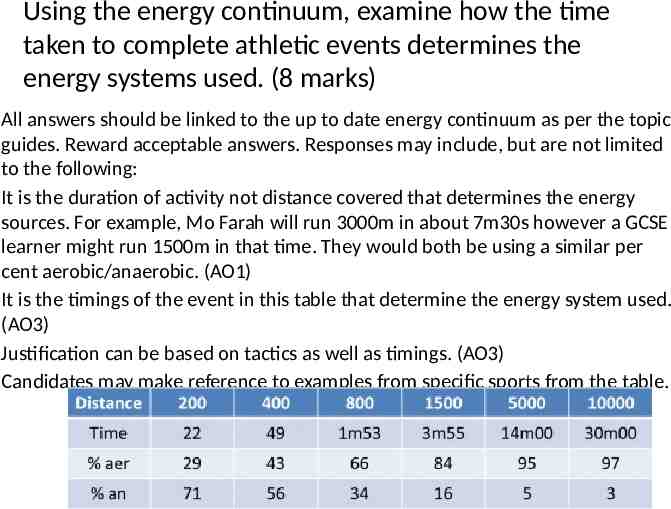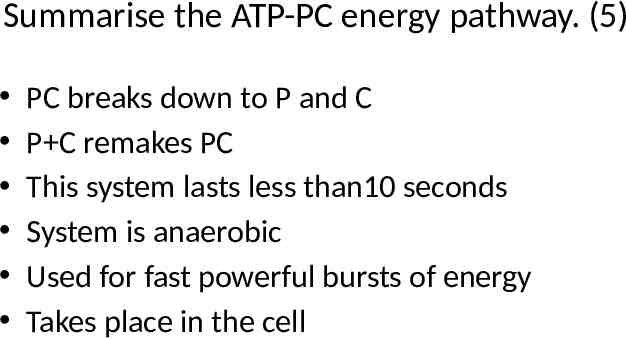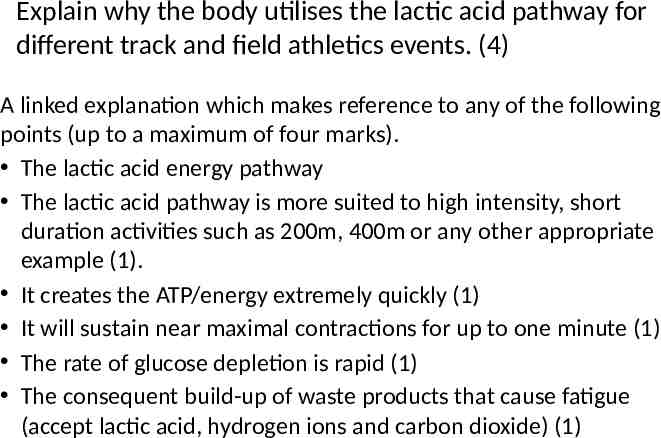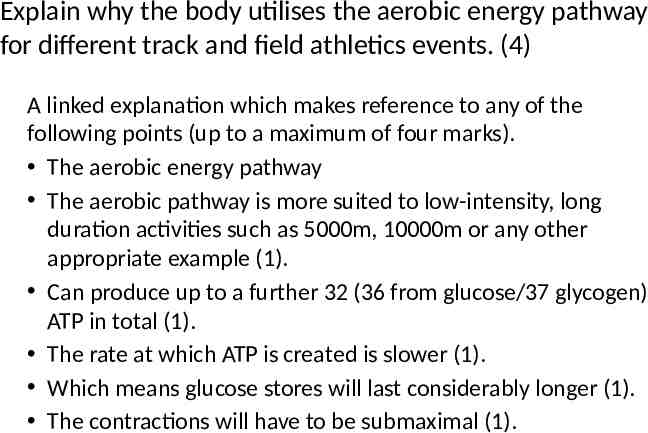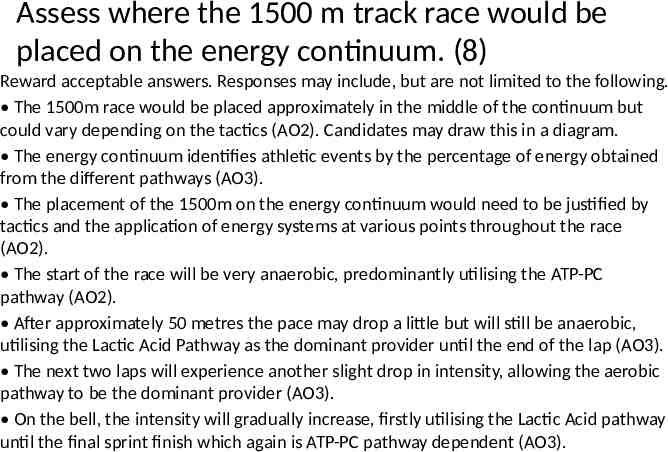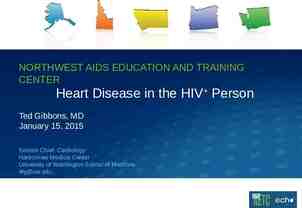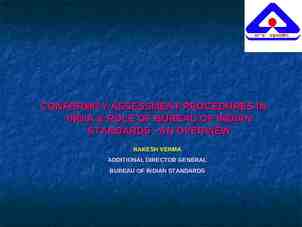a) Define the term concentric muscle action. (1) b) Using a sporting
85 Slides3.72 MB

a) Define the term concentric muscle action. (1) b) Using a sporting example, outline a concentric muscle action. (2) a) Concentric contractions involve the muscle shortening while under tension b)

a) Define bradycardia. (1) b) Outline why the adaptations leading to bradycardia might be beneficial to trained athletes. (3)

Explain how type 2X muscle fibres are suited to sports that require sprinting. (5)

Explain the physiology of a muscular contraction from nervous impulse to initiation of contraction. (6)

Explain wave summation. (6)

Using Newton’s laws of motion, outline how a swimmer achieves initial forward momentum from a dive. (3)

Outline the four phases of the cardiac cycle. (4)

Two rugby players go into a tackle. Player A has a mass of 71 kg and is accelerating at a rate of 2m/s/s. Player B has a mass of 83 kg and is accelerating at a rate of 3m/s/s. Using Newton’s Second Law of Motion, calculate the resultant force at the point of impact. You must show your working. (3)

Using examples, evaluate why muscle fibre types make athletes suitable for different events. (15) CONTINUED .

Using a team game as an example, explain why two positions may have different optimal weights. (4)

Explain the use of the RPE scale to calculate the intensity of training. (2)

Outline the advantages of circuit training. (4)

The shape of an object affects airflow over it. Using sporting examples from individual activities, examine how athletes utilise this knowledge to adopt a technique to improve their performance. (8)

The flight path of a ball is affected by applying spin to it. Examine the effect of backspin on a tennis ball. (8)

Identify the two different classifications of sporting injuries. (2) Acute – (1) Overuse-(1)

Examine the different types of cruciate ligament injury. Include cause, consequence and rehabilitation in your answer. (8) CONTINUED .

Assess the suitability of a multi-stage fitness test for an 800m swimmer. (8)

Using the data in Tables 2, 3 and 4, discuss what it tells the coach about his players’ strengths and weaknesses. (15) CONTINUED .

Outline what is meant by an unhealthy lifestyle. (4)

Define the term pressure gradient. (1) A pressure gradient is when there is a difference in neighbouring or adjoining pressures (1).

Examine how the body uses pressure gradients in order to facilitate inspiration and expiration. (6)

Identify four muscular-skeletal adaptations of the body to weight training, using heavy weights and few repetitions. (4)

Examine the purpose of warming up to improve cardiac function during sporting activity. (6)

Two rugby players go into a tackle. Player A has a mass of 92 kg and is accelerating at a rate of 2m/s/s. Player B has a mass of 65 kg and is accelerating at a rate of 3m/s/s. Use Newton’s 2nd Law of Motion to: (a) calculate the resultant force at the point of impact. You must show your working. (4) (b) identify which player the resultant force favours (1) a) Newton’s 2nd Law of Motion - force mass x acceleration (F MA) (1) Player A: F 92 x 2 184 N (1) Player B: F 65 x 3 195 N (1) Resultant force of 11 N (1) b) Player B

Outline how force is produced during the contraction phase of a muscle using sliding filament theory. (5)

Analyse the view that muscle fibre make up dictates a person’s sporting pathway. Use your knowledge and understanding from across the course of study to answer this question. (12) Continued .

Continued

Explain why an athlete might take three different types of nutritional supplements. (6)

Describe how agility is used by performers in team games. (3) Any three of: To try to dodge an opponent in a rugby union match (1) To create space in a hockey match (1) To mark an opponent in a football match (1) To lose a marker in a netball match (1) Other appropriate examples are acceptable.

Explain how an athlete’s diet can aid the recovery process. (3)

Explain the changes an athlete should consider making to their diet during preparation for a marathon run. (5)

The 2016 Olympic Games will be held at sea level in Rio de Janeiro. Assess why an athlete might prepare for an event in the Olympics with altitude training. (8)

Compare the use of free weights versus machines for weight training. (12) Continued .

Using sporting examples, explain the difference between rotation and circumduction. (4)

Calculate the ‘moment of force’ at the knee in both exercises. You must show your working. (i) Front squat (2) (ii) Smith machine squat (2)

During intense racing, an endurance swimmer will require a greater volume of air per breath than when at rest. Explain how the swimmer achieves a greater volume of air per breath during a race. (6)

Explain how three of the structural characteristics of slow twitch muscle fibres enable the fibres to be better suited to endurance activities. (6)

Structural responses provide functional benefits. Explain how four structural responses experienced during a warm up would lead to functional improvements in a performance. (8)

Discuss the likely effects of an unhealthy lifestyle on the body. Use your knowledge and understanding from across the course of study to answer this question. (15)

Other than cooling down and wearing compression clothing, identify three strategies used by athletes to speed up recovery. (3) Any three of: massage (1) ice baths (1) diet (1) physiotherapy (1) ultrasound (1) cryotherapy (1) nutritional supplements (1)

Explain how (i) cooling down and (ii) compression clothing can speed up the recovery process. (6)

Explain why it is important for an athlete to recover after exercise. (6)

Explain how periodisation can be used to minimise the risk of injury (4)

An athlete uses periodisation to plan their training programme. Examine how technology used to measure exercise intensity can contribute to successful periodisation for the athlete. (8)

An elite marathon runner is returning to the sport after a long-term injury. He intends to use heart rate (HR) as a means of measuring the intensity of his training. His current resting HR is 45 bpm and maximum HR is 196 bpm. (i) State Karvonen’s theory. (ii) Using Karvonen’s theory, calculate the runner’s heart rate reserve. (iii) Calculate the runner’s: lower resting heart rate and higher resting heart rate

Define the terms isotonic, hypertonic and hypotonic in the context of sports drinks. (3) Isotonic is when the glucose osmolality of the drink is the same as blood (1). Hypertonic is when the glucose osmolality of the drink is greater than the blood (1). Hypotonic is when the glucose osmolality of the drink is lower than the blood (1).

Assess the merits of hypotonic drinks for a marathon runner. (8)

Assess the use of POLICE rather than RICE as a rehabilitation strategy for sporting injuries sustained in a team game. (8)

Analyse whether interval training is a valid method of training for an elite marathon runner. (15) Continued .

Using examples, outline the two types of isotonic muscle action. (4)

Using sporting examples, examine how the body uses third class levers at the elbow joint. (6)

Describe the effects of an unhealthy lifestyle on the cardiovascular system. (4)

Explain how four different characteristics of fast glycolytic (type IIx) fibres enable them to be better suited for power activities. (4)

Explain how three structural adaptations cause a corresponding functional response in skeletal muscle as a result of power-based training. (6)

Analyse the effect of a warm-up on performance. Use your knowledge and understanding from across the course of study to answer this question. (12) Continued .

Use a sporting example to outline exercise economy (2) Exercise economy is the energy required to maintain a constant velocity of movement For example, if two people running at the same speed (1) One of them could be using less energy than the other because they are more economic. (1)

Outline how four different supplements are used to aid an athlete in recovery. (4)

Explain the advantages of using compression clothing. (6)

Summarise periodisation (5)

Explain why an athlete would use assisted training. (4)

Outline the factors that would influence the results gained from the Margaria Kalamen fitness test. (3)

Assess whether cross training is a useful method of training for a games player. (8)

Compare the use of the Multistage Fitness Test, the Yo-Yo test and the Cooper 12 minute run for an athlete in determining their maximal aerobic fitness VO2 max. (12) Continued .

Examine how the slow component of recovery allows an athlete to return to homeostasis. (8 marks) All answers should be linked to the slow component of recovery. Reward acceptable answers. Responses may include, but are not limited to the following: Slow component of recovery occurs after the fast component and includes anything after the first 3 minutes when ATP-PC restored in the fast component. (AO1) The replenishment of energy stores refuels the athlete over 24-48 hours (AO1) Use of the 2 hour window of opportunity to maximise glycogen resynthesis (AO1) Rehydration allows the athlete to return to homeostasis (AO1) Physical cooling and thermoregulation aligns body temperature back to resting levels. (AO3) Re-saturation of myoglobin prepares the athlete for future aerobic activity. (AO3) Re-synthesis of protein allows repair of damaged muscle fibres after up to 72 hours. (AO3) Re-synthesis of glycogen and carbohydrate allows energy to be restocked over 24-48 hours. (AO3) Removal of lactate and hydrogen ions (AO3) The indicative content is a guide to the responses candidate may give. Other valid responses which answer the question correctly can be credited as appropriate.

Using the energy continuum, examine how the time taken to complete athletic events determines the energy systems used. (8 marks) All answers should be linked to the up to date energy continuum as per the topic guides. Reward acceptable answers. Responses may include, but are not limited to the following: It is the duration of activity not distance covered that determines the energy sources. For example, Mo Farah will run 3000m in about 7m30s however a GCSE learner might run 1500m in that time. They would both be using a similar per cent aerobic/anaerobic. (AO1) It is the timings of the event in this table that determine the energy system used. (AO3) Justification can be based on tactics as well as timings. (AO3) Candidates may make reference to examples from specific sports from the table.

Summarise the ATP-PC energy pathway. (5) PC breaks down to P and C P C remakes PC This system lasts less than10 seconds System is anaerobic Used for fast powerful bursts of energy Takes place in the cell

Explain why the body utilises the lactic acid pathway for different track and field athletics events. (4) A linked explanation which makes reference to any of the following points (up to a maximum of four marks). The lactic acid energy pathway The lactic acid pathway is more suited to high intensity, short duration activities such as 200m, 400m or any other appropriate example (1). It creates the ATP/energy extremely quickly (1) It will sustain near maximal contractions for up to one minute (1) The rate of glucose depletion is rapid (1) The consequent build-up of waste products that cause fatigue (accept lactic acid, hydrogen ions and carbon dioxide) (1)

Explain why the body utilises the aerobic energy pathway for different track and field athletics events. (4) A linked explanation which makes reference to any of the following points (up to a maximum of four marks). The aerobic energy pathway The aerobic pathway is more suited to low-intensity, long duration activities such as 5000m, 10000m or any other appropriate example (1). Can produce up to a further 32 (36 from glucose/37 glycogen) ATP in total (1). The rate at which ATP is created is slower (1). Which means glucose stores will last considerably longer (1). The contractions will have to be submaximal (1).

Assess where the 1500 m track race would be placed on the energy continuum. (8) Reward acceptable answers. Responses may include, but are not limited to the following. The 1500m race would be placed approximately in the middle of the continuum but could vary depending on the tactics (AO2). Candidates may draw this in a diagram. The energy continuum identifies athletic events by the percentage of energy obtained from the different pathways (AO3). The placement of the 1500m on the energy continuum would need to be justified by tactics and the application of energy systems at various points throughout the race (AO2). The start of the race will be very anaerobic, predominantly utilising the ATP-PC pathway (AO2). After approximately 50 metres the pace may drop a little but will still be anaerobic, utilising the Lactic Acid Pathway as the dominant provider until the end of the lap (AO3). The next two laps will experience another slight drop in intensity, allowing the aerobic pathway to be the dominant provider (AO3). On the bell, the intensity will gradually increase, firstly utilising the Lactic Acid pathway until the final sprint finish which again is ATP-PC pathway dependent (AO3).











